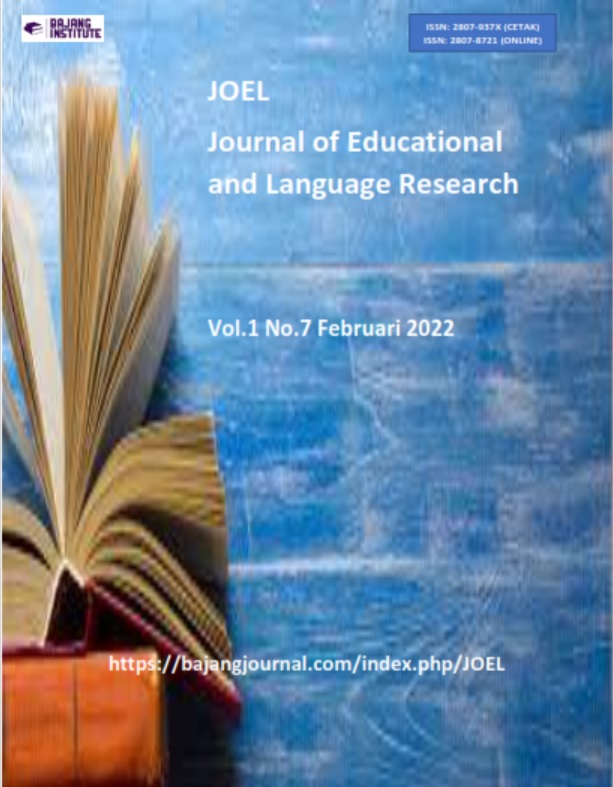ASMA NADIA's NOVEL SAKINAH BERSAMAMU APPRECIATION IN DISCUSSION CONTEXT STUDY
DOI:
https://doi.org/10.53625/joel.v1i7.1479Keywords:
Asma Nadia Novel Sakinah Bersamamu, Context StudyAbstract
The problem in this study is what is the context of the discourse contained in the novel Sakinah Bersamamu by Asma Nadia?. The purpose of this research is to describe the context of discourse in Asma Nadia's Sakinah Bersamamu novel. This research is focused on analyzing the discourse context in Asma Nadia's Sakinah Bersamamu novel. The population in this study is the novel "Sakinah Bersamamu" by Asma Nadia, which consists of 333 pages published by Asma Nadia Publishing in 2012. The sample in this study is the discourse in the novel Sakinah Bersamamu by Asma Nadia. The main research instrument in this study is researcher himself. Researchers play a full role in research activities from observing, recording, to analyzing data and describing it. The data analysis process begins by describing the data obtained in the field. Data obtained through reading novels. The results of this study conclude that the context of the discourse contained in the novel Sakinah Bersamamu by Asma Nadia is the physical context (topic of events, actors' actions, and the place of events), epistemic context, and social context.
References
Andianto, Kunjana. 2010. Pragmatics of Indonesian Imperative Politeness. Yogyakarta.Erlangga.
Arikunto, Suharsimi. 2012. Research Procedure: A Practical Approach. Jakarta: Rineka Cipta.
Cahyono, Abdul Syukur. 2010. Study of Speech Acts. Surabaya. National Business Publisher.
Eriyanto. 2011. Content Analysis: An Introduction to Methodology for Research in Communication and Other Social Sciences. Jakarta: Kencana Prenada Media Group
Kridalaksana, Harimurti. 2008. Language Functions and Language Attitudes. Ende: Nusa Indah Publisher.
Leech, Geoffy. 2011. Principles of Pragmatics. (Translated) M. D. D. Oka. Jakarta: University of Indonesia.
Moeleong, L. J. 2014. Qualitative Research Methods. Bandung: Rosdakarya Youth.
Mulyana. 2005. Study of Discourse Theory, Methods, and Application of the Principles of Discourse Analysis. Yogyakarta: Tiara Wacana
Nadar, F. X. 2009. Pragmatics and Pragmatic Research. Yogyakarta: Graha Ilmu.
Nurgiyantoro, Burhan. 2013. Theory of Fiction Studies. Yogyakarta: Gadjah Mada
Rahardi, Kunjana. 2009. Sociopragmatics. Jakarta. Erlangga.
Rohmadi, M. 2010. Pragmatics Theory and Analysis. Yogyakarta: Media Circle.
Rustono. 2009. Principles of Pragmatics. Revised Edition. Semarang: IKIP Semarang Press
Siswantoro. 2010. Literary Research Methods. Yogyakarta: Student Library
Sugiyono, 2017. Research and Development Methods (Research and Development). Bandung: Alphabeta.
Sumarlam. 2010. Theory and Practice of Discourse Analysis. Surakarta: Pustaka CakraSurakarta.
Tarigan, Henry Thunder. 2008. Teaching Pragmatics. Bandung: Space.
Wijana, I.D.P. 2007. Fundamentals of Pragmatics. Yogyakarta: Andi.
Yule, G. 2006. Pragmatics. England: Oxford University Press (Translation into Indonesian by Indah Fajar Wahyuni). pragmatics. Yogyakarta: Student Library.
Zamzani. 2007. Sociopragmatic Studies. Yogyakarta: Cipta Pustaka.











